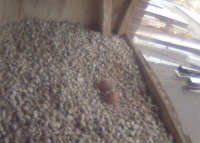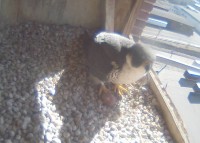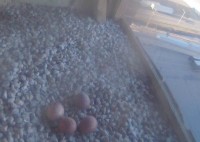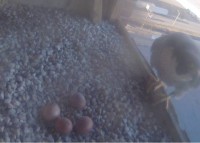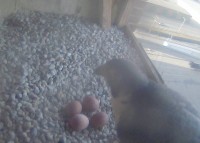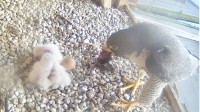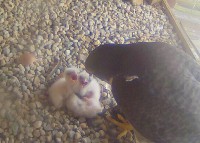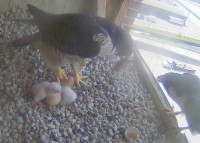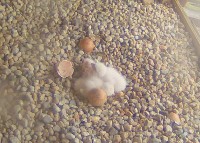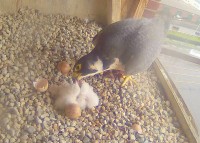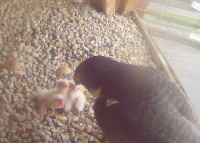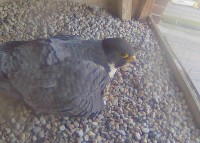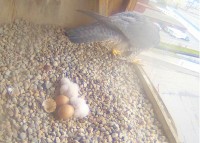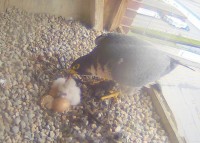Lawrence Peregrines: incubation process
April 4, 2020 in In the Nest Box
Let’s take a look at the overall incubation process and what happens in the early stages! 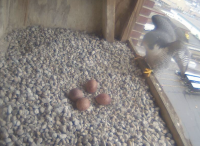 Both sexes have paired lateral brood patches. Less well developed in male. Belly area may function as patch also but less edematous and vascular than breast (TJC). In this photo, the male is taking a break on outside edge of the nest box. He waited a while until the female showed up and set down on the perch pole outside the nest box.
Both sexes have paired lateral brood patches. Less well developed in male. Belly area may function as patch also but less edematous and vascular than breast (TJC). In this photo, the male is taking a break on outside edge of the nest box. He waited a while until the female showed up and set down on the perch pole outside the nest box.
Incubation Period
The peregrines at this location have usually incubated their eggs for 29 to 33 days. In the early days of brooding it’s important to keep the eggs as close to their ideal incubating temperature as possible. If it is too hot or too cool and the eggs won’t develop properly. Later in the incubation process, proper temperature isn’t quite as important. After a couple of weeks the falcons will be able to leave the eggs uncovered for longer periods of time. Sometimes leaving the eggs uncovered frequently, or for long periods can mean that the eggs hatch a few days later than normal. This is a very well protected nest box in a location where the resident peregrines will not be disturbed, so they will tend to incubate steadily until the eggs hatch.
According to Derek Ratcliffe, the eggs of the peregrine falcon are among the most handsome laid by any species of bird! He notes that the prevailing color is reddish-brown with a wide variation. The surface of the fresh egg has variable amounts of bright red-brown markings appearing as a freckled, mottled, or blotched layer which can easily be rubbed off when the shell is wet. This non-fast layer of pigment gives a peregrine egg much of its beauty and richness, and in fresh specimens is often accompanies by a kind of bloom!
During the normal course of incubation, one of the adults is nearly always on the nest. Exceptions are during disturbance, for short periods on particularly warm days, or for a few minutes during food exchanges. The female does the majority of incubation. The male brings food to her several times daily, or sometimes simply relieves her and takes a turn on the eggs while the female eats, preens, and relaxes. When she returns to the nest box to relieve the male, he usually is waiting on the outer edge of the nest box. It is often a a challenge to identify the male from he female, as the male’s leg band is not always easy to see. It will be helpful to identify field marks to distinguish the sexes.
Embryonic Development
Many questions have come in about exactly what happens during incubation, in terms of embryonic development. It is a fascinating question and related to the very mystery of life, and how young peregrines develop inside the egg. So, what happens when?
Over the next number of days, we’ll look a bit closer at how the embryo develops. Resources will include two book on avian embryonic development and an old blog, specifically about peregrine falcons, that includes a number of entries on this topic.
The age of the embryo when the egg is laid varies. Peregrines tend to lay eggs during the night or early morning or in the evening.; if the egg is not complete until later in the day, it will probably not be laid until the next day. The rate of development of the embryo once the egg is laid also varies. If the eggs are cooled after laying, development of the embryo ceases until the temperature rises again. Development can resume even after the eggs have been cooled for several days. The temperature of eggs incubated by their mother is 106 degrees Fahrenheit The temperature of course will vary when the peregrine leaves the eggs to eat, etc. All of this affects the rate at which the embryo develops and, therefore, how long it takes for the chick to hatch.
The first 4 days are essential. A lot is going on in those 4 days. Let’s have a closer look inside the eggshell. It is a magic journey through the universe of the dawning of life itself.
First Day: The Journey Begins
Before the Egg is Laid:
* The egg is fertilized.
* The zygote divides and begins to grow.
* The cells segregate into groups of specialized function.
* The embryo nearly stops growing between laying and incubation.
During Incubation:
* The area pellucida and area opaca of the blastoderm develop.
MAJOR EVENTS
Second day:
*27 hours: The alimentary tract appears.
*28 hours: The brain crease begins to form.
*29 hours: Somites appear.
*31 hours: The brain and nervous system begin to form.
*32 hours: The head fold begins to form.
*34 hours: Blood islands appear.
*35 hours: The eyes begin to form.
*37 hours: The heart begins to form.
Third day
*52 hours: The ears begin to form.
*58 hours: The heart starts to beat
Fourth Day
*76 hours: head turns to the left
*78 hours: Amnion has enclosed the embryo
*80 hours: Allantois begins to form
*88 hours: The beak begins to form.
*92 hours: The leg begins to form.
*94 hours: The wings begin to form
Literature cited:
White, C. M., N. J. Clum, T. J. Cade and W. G. Hunt. 2002. Peregrine Falcon (Falco peregrinus), version 2.0. In The Birds of North America (A. F. Poole and F. B. Gill, Editors). Cornell Lab of Ornithology, Ithaca, NY, USA. https://doi.org/10.2173/bna.660
Ratcliffe, D. 1993. The Peregrine Falcon. 2nd ed. Carlton, England: T. and A. D. Poyser.
Cade, T. J., J. H. Enderson and J. Linthicum. 1996a. Guide to Management of Peregrine Falcons at the eyrie. Boise, ID: The Peregrine Fund, Inc. (Excerpt: Linthicum, Janet. Observing Breeding Behavior)
Veldhuis, Froona, Embryo: the first four days, Sept. 6, 2008, http://falcoperegrinus-froona.blogspot.com/2008/09/embryo-first-4-days.html
